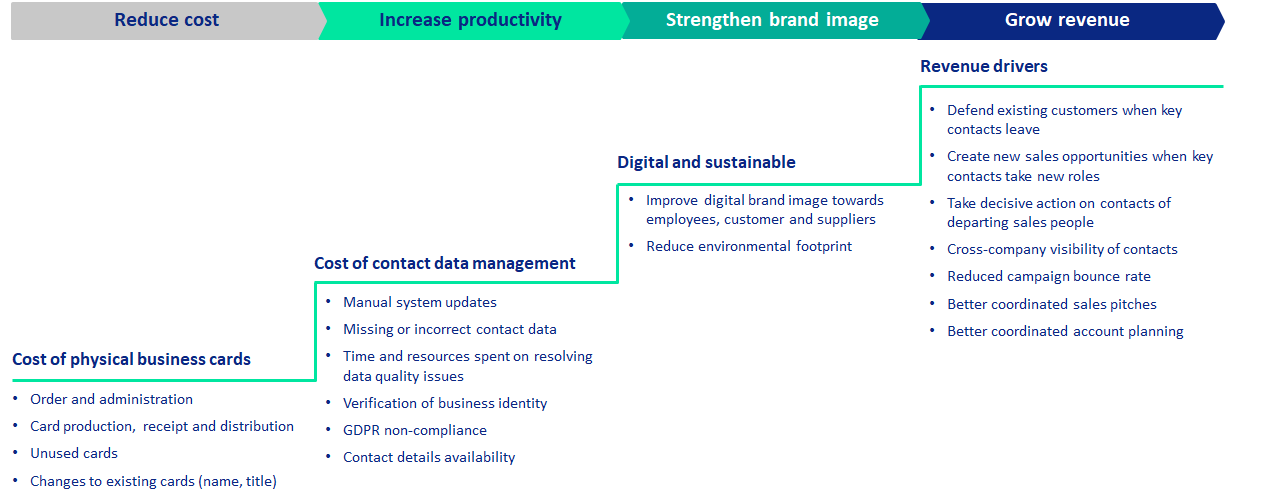Stuart Wynn, CEO of Stinto
What exactly is the cost of poor customer contact data for a business? This is the question we are regularly confronted with when speaking with current and potential customers. It’s a good question, but extremely difficult to answer with any level of precision. There are however a number of key questions that can give an indication of the cost, and lost commercial opportunity, connected with poor customer contact data quality.
If you work for a B2B company with a direct sales force, then the successful management of customer relationships plays a big part in the commercial success of your company. Regardless of how well you think your product or service fits the need of a particular market segment, at the end of the day, your success or failure will be largely determined by a series of commercial touchpoints between your sales team, and the customer. Like it or not, business is fundamentally a social activity, and as such, success is increasingly determined not by what you know, but more by who you know, and how well you know them. Unfortunately however, this is the start of a major challenge for most companies unable to answer the question: “who exactly are our customers?”.
Whether they are aware of it or not, a company’s network of external relationships is one of its biggest intangible assets. Access to this network is managed by employees. Unfortunately the tools provided by companies, to employees, for the purpose of managing this network, are not fit for purpose.
As a result, most company’s important commercial contacts are typically scattered across a number of different locations, including contact lists in Outlook, in the address book of employees mobile phones, on email signatures, as a pile business cards on employee desks, or as connections on LinkedIn. Everywhere except where they should be; updated in the company’s CRM!
Even in instances where the data does successfully reach CRM, the static nature of this data means that it is in decay from the second it is entered into the system. To understand the result, you need look no further than Salesforce.com themselves, who estimate that 80% of all data contained in their sales and marketing cloud is “dirty” (incomplete, incorrect, duplicate or otherwise of a poor quality). “Accurate information is the life blood of an effective sales force. Without it, management doesn’t have the data to make good decisions, sales reps don’t have the tools to turn leads into customers, and the company will find it difficult to reconcile CRM data with data in other systems. The result? Lost opportunities and revenue, and frustrated customers.”
Stinto’s value stairs: Assessing the value of digital contact management

So, back to the initial question, what is the cost of poor customer contact data? At Stinto, we have identified four clear questions that you can ask yourself in order to start determining the unnecessary cost that poor contact data has on your business:
1. What do we currently spend on physical business cards?
While it might seem like a strange place to start, most businesses would be shocked if they discovered that most spend approximately €30 per employee per year on physical business cards. These costs typically go unnoticed because the procurement of business cards is most often decentralised, and posted as “miscellaneous costs”. Important to remember that 88% of business cards are thrown away within a week of being received, without the data ever reaching the intended system – which begs the question, what is the point of them?
2. How much time do we currently spend updating customer and contact masterdata in CRM, and are we compliant?
An average sales person spends 6 hours a week updating CRM – this equates to 15% of their time or approximately €12.000 per year. Approximately half of this time is dedicated to opportunity management, and the other half to customer and contact masterdata. Given that investment, you need to ask yourself four additional questions:
a. is the time used enough to cover our entire customer base?
b. if not, how much extra time is required?
c. what are the additional costs of not having all customer and contact masterdata in CRM?
d. are our current practices GDPR compliant?
3. How does our current solution impact our brand image in terms of “digital” and “sustainable”?
Almost every company on the planet is in the midst of a digital transformation, and, it looking for ways to reduce their environmental footprint. No matter which business process you look into, converting paper to data is the most effective way to positively impact both goals at the same time. Or, said anther way, if your company cannot digitalise a tiny piece of paper, how will you ever succeed with the more ambitious initiatives on your sustainable, digital journey .
4. Do our current practices for handling customer and contact masterdata support our ability to defend and grow the top-line?
Your commercial success hinges on your ability to defend and grow existing customers, as well as winning new customers. With that said, how can you defend, grow or win customers, if you do not know who they are. Your sales people come and go, as do all the people working within your customers organisations. With all this working against you, what would it be worth to have live connections to your customer contacts, that notified you of changes in real-time as they occurred, and allowed for easier contact management, and all the commercial activities related herto – including campaigns, account planning, sales pitches etc.
While the answers to these questions probably give rise to some scary internal reflections, it is even scarier to consider a future where you as a company do not have control over your network of external relationships. Not only do you continue to be non-GDPR compliant, and miss commercial opportunity, but, your success or failure will reside exclusively with the behaviour of your commercial team, and their willingness to manage and share their contacts, in the face of an increasingly turbulent world where people change jobs more and more frequently, and data is decaying faster than ever.
